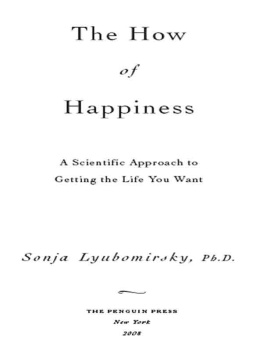and our daughter, Jessie Leo.
In happiness I could not have predicted.
Get Happy
Myths of the Modern Mind
I n the four hundred years from the beginning of the sixteenth century to the end of the nineteenth, women wore corsets to shape their figures. At first the ideal was to have a flat-front, cylindrical shape; later the ideal was a gentle hourglass, big at the breasts and hips, and smoothly slanting in toward a small waist. Corsets also helped support the heavy dresses that women wore in this period, which often included bustles at the hips and rear end, scaffolding out a hugely exaggerated frame. If the fabric creased anywhere, it hurt, causing too much pressure in one place, so corset makers put in structural elements to keep the pressure distributed across the whole torso. These were stays, made from steel, whalebone, or ivory. Corsets were always snug enough to be supportive, but in the nineteenth century the fashion of tight-lacing began, giving women a shape that looked like an actual hourglass. With tight-lacing beginning in puberty, a womans ribs grew compressed, forcing her lungs, liver, and heart to be displaced and squeezed, and her intestines could barely move enough to function. The pressure on womens lungs caused a lot more fainting than might otherwise have occurred, and there were occasions of serious organ damageeven of prolapsed uterus, where the pressure forces the uterus down into the vagina.
Today we wear soft cotton shirts and pants, and women get support for their breasts from other supple materials designed for comfort. But the same woman who pities the corseted girls of the past may very well go to the gym five times a week to do a hundred sit-ups on a Swiss ball and an hour of aerobics. Most likely she is exacting about her diet, eats foods that have been stripped of various life-sustaining elements, and thus keeps her body fat to a minimum. The whalebone ribbing is gone from just beneath her dress, but now her own ribs show through the cloth! A modern woman may wear a breast-enhancing bra, or even have surgery to install what amounts to bulbous bustles just beneath the skin of her bosom. She may damage her body in her exertionsknees and wrists seem particularly vulnerableand she may lose control of the dieting and find herself unable to eat normal meals and maintain health, particularly reproductive function. Also note that though it was hard to fail at wearing a corset, many women today fail at their body goals, spend massive amounts of money on half-used gym memberships and diet programs, and, worst of all, feel tortured by their failure. Indeed, other people will judge a woman with a slim body to be happier than the woman trapped in her fat.
So who is crazier, the culture that had women bind their bodies, or us? Even when both of these practices are carried out in moderation, does it make more sense for us to expect women to come in various sizes but to squeeze them all into the same shape, from the outside, or does it make more sense for the culture to accept various shapes but idealize the lack of body fat, forcing people to exert all sorts of internal pressures on themselves? We have a commonly held belief today that corsets were cruelly uncomfortable and bizarre, but our own practices do not suffer a comparison well. History may be read as a source of anthropological insights, but we can also turn the light of those insights on what we do today. It is not easy to find the relevant connections, but if we come to comprehend an Old World point of view as ordinarythe absurd becomes normalthe effect on how we view our modern world can be profound: the normal becomes absurd. Often, the modern point of view reveals itself to consist of bossy, shaming, controlling nonsense. This realization alone can give us a bit of freedom from the mental corsets of our day. Most of the strictures we live under are just cultural stories, no more inherently true than the cultural stories of any other period in history.
Our times are not exactly like any other time in history. We are very special. But not as special as we think. The fact that you can send a probe to Mars doesnt mean you are better at living a normal life. It is true that modern experimental science can turn up new kinds of information, but brain scans and scientifically constructed questionnaires answer only the questions that you ask. Happiness is a subjective matter. How superior, then, are we to those of earlier centuries who analyzed happiness using observation and contemplation? Historically, people have studied happiness from their own point of view. That may seem subjective, but when you yourself judge the happiness of fifty people you have known, it is always the same person playing judge. That is a big benefit. When, in the style of modern experimental science, we ask the fifty people to report their own experiences, they may each have such varied expectations that their reports are meaningless. Such studies have shown that a lottery winner and an accident victim left paraplegic both return to their genetic happiness set points a year after the event. Historically, we have always known of happy types, but the modern idea of set points may go too far.
Perhaps you can look at your life and say that you were reasonably happy in most periods. But ask yourself whether you were happier when things were going your way than when you suffered a major setback. We may thank science for reminding us that good and bad luck do not change things as much as we fantasize and worry that they will. But the old intuitive patterngood stuff is betterholds up well. Our present-day affection for the idea of happiness set points also seems a bit disrespectful to the countless people who have left records saying that events or society had stolen much of the happiness they should have had. The evidence for a set point is a study of identical twins separated at birth, some of whom seemed to have very similar mood ranges. The evidence against it comes from millions of attestations over thousands of years. Our science of happiness can be fascinating, but it is not definitive. Our forebears had other ways of judging what makes people happy, and future generations will have others still. We may think we are much more sophisticated than people in the past, but the happy truth is that we can learn a lot from history.
Our era believes that happiness requires a particular relationship to physical exercise, legal and illegal drugs, food, public decorum, sexual normality, and material and media culture. It has no more claim to truth on these matters than any other. People argue about the details but accept the basic modern assumptions as true, based on science and common sense. This book seeks to prove that the basic modern assumptions about how to be happy are nonsense and that we do not have to listen to people argue about the details. That is a big claim, I know. But I am convinced both that it is accurate and that it is a wonderfully therapeutic idea if you can fully take it in. All disciplines, from physics to comedy, may be said to progress, but all disciplines do not equally generate useful ideas that must be understood by the next generation if the game is to be advanced. Once the whole idea of what we are doing changes, I no longer need to know the details of the old obsession. The circumference of a Caucasian head, the number of changes in a blue-grass songanthropology and popular music go on, to varying degrees, without needing or wanting this information. We think of our version of a happy life as more like physics than like pop songs; we expect the people of the next century, say, to agree with our basic tenetsfor instance, that broccoli is good for a happy life and that opium is badbut they will not. Our rules for living are more like the history of pop songs. They make their weird sense only to the people of each given time period. They arent true. This book shows you how past myths functioned, and likewise how our myths of today function, and thus lets you out of the trap of thinking you have to pay heed to any of them. This process of examining myths is also good for sharpening our ability to see truths other than our own. We get to lose some respect for our own dogma, and to gain some respect for the dogma of other historical periods. This is a necessary and sufficient characteristic for understanding other historical erasthat is, for doing good history.









